The Virtual Reality Groundswell
Part Four: Stormy Seas Calming Into Clear Opportunities for Operators
by Bob Cooney
The creation of waves requires wind to blow over the open ocean for long periods of time. The sea state inside a large storm is chaotic, with huge waves breaking in every direction. You’ve seen the dramatization in movies like The Perfect Storm, where the little fishing boat is tossed all over the place. The virtual reality business has been like this for the last several years, where the winds of technology evolution, immature business models and unmet consumer expectations have led to the stormy seas of confusion, paralysis and doubt.
Those storm waves travel over thousands of miles of open ocean, slowly and eventually organizing into what we call groundswell. On the coast of California that groundswell emerges from the depths of the ocean as perfect surfable waves. Clean lines of green water that break over reefs and peel down the beach, leading to epic rides. So consider me your virtual reality surf forecaster; the prediction is that the stormy sea of early VR is beginning to organize into clear opportunities for location-based entertainment operators.
There are already multiple virtual reality products on the market that seem to be earning for operators. Hologate, distributed in North America by Creative Works, launched to unprecedented success for a new company at IAAPA this past year. The 4-player tethered VR system debuted with two games: a competitive game that looks a bit like Tower Tag (learn more about this further down), but I feel isn’t quite as polished or fun and lacks an appropriate first-time user experience, and a co-op wave shooter called Simurai, which I have panned in my reviews. It is chaotic, lacks any sense of peril, and after a few minutes feels like a shooting gallery.
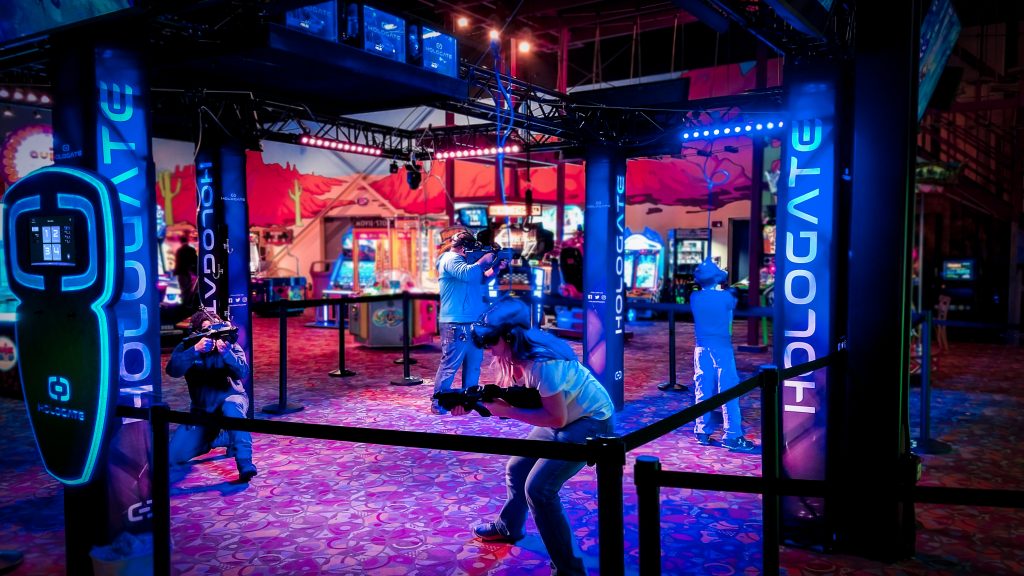
That hasn’t stopped Hologate from earning huge numbers for operators, with some reporting earnings exceeding $5,000 a week. They recently shipped a third game, Cold Clash, aimed at families with younger children. It seems to be working. This just shows the hunger the public has for VR.
Virtual Rabbids: The Big Ride is a 2-player motion simulator from LAI Games and Ubisoft, where riders strap on an HTC Vive headset and get bounced around on a DBox motion base, as they careen down a virtual roller coaster-like experience. The product is positioned as not requiring an attendant, but your mileage may vary. Several operators I’ve spoken to have been happy with the product and its earnings. It doesn’t come with much replay value in my opinion, as it’s more of a ride-along experience lacking interactive game play, but that seems to be the story for most of the early VR products: they feel more like virtual reality technology demos than true immersive games. But at this time, there’s a place for that in the market.
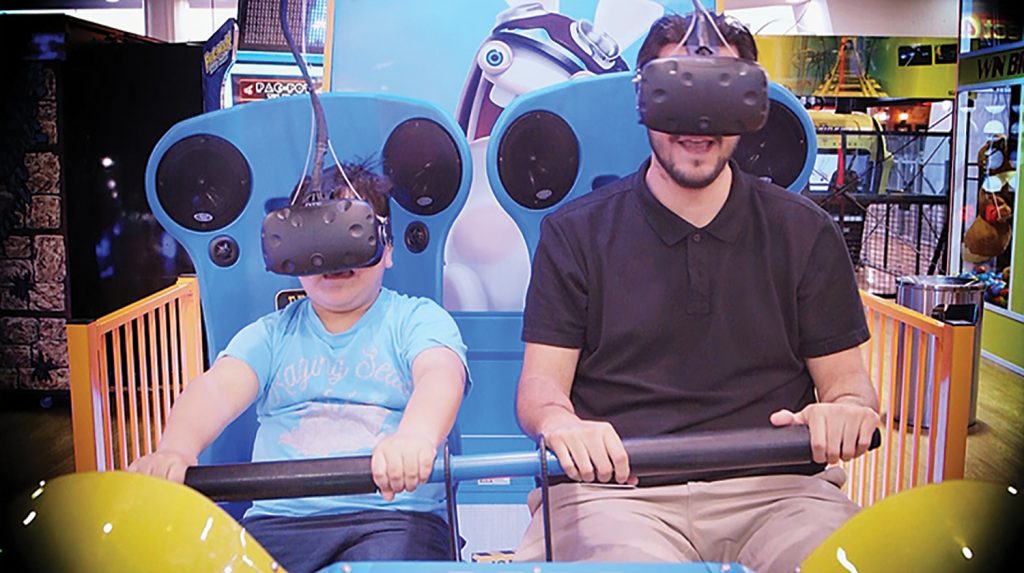
Games vs. Experiences
Gameplay is critical to repeat playability. That has long been true in the games business and it’s no less valid for VR. While large, free-roam VR systems like The VOID and Dreamscape Immersive have so far focused on experiences on rails, Zero Latency VR has developed four warehouse-scale, free-roam games.
With ZL, each player gets a laser tag-like scorecard via email when they are finished, highlighting that player’s performance across a number of metrics, and across different levels of the game. The impact on repeat play has been stunning. Over 60 percent of the Zero Latency tickets sold at Octane Raceway in Phoenix this year have been to repeat players, and this is at $50 a game, a price point that terrifies most amusement operators.
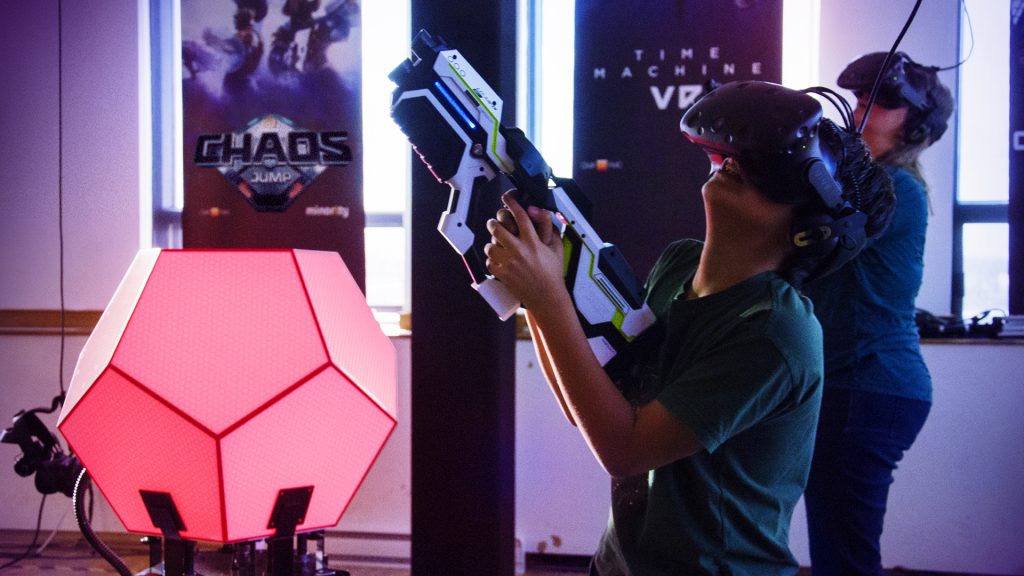
The next wave of VR products I see over the horizon are based upon more mature gameplay models. Minority Media, a company in the Canadian gaming hub of Montreal, is about to release a VR product called Chaos Jump. Based upon the 4-player HTC Vive and truss model that Hologate introduced, Chaos Jump substantially raises the bar on gameplay.
With multiple scoring vectors, clear winners in each level and a randomizer that selects from 14 different level designs to make each game played entirely different, I expect this game to be wildly successful. Minority Media is a game design studio made up of employees with decades of experience working for companies like EA, Ubisoft and other giants. Their game development chops are clear in the high-production-value, story-driven content and addictive game mechanics.
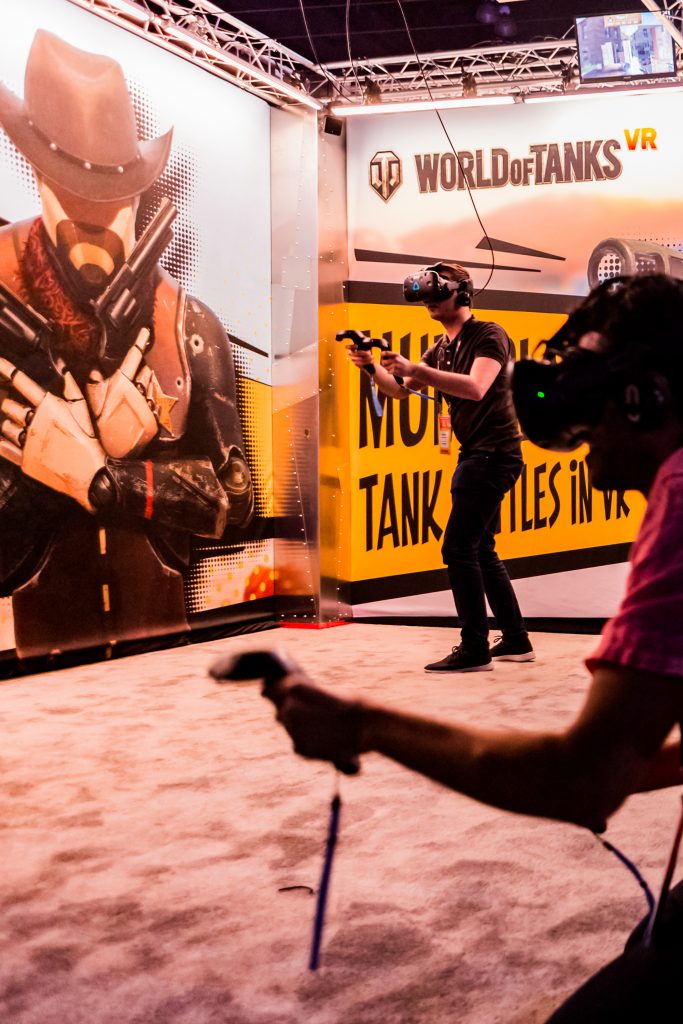
Another company about to burst onto the market with a Hologate-like setup is Neurogaming from Russia. A joint venture between VR Tech, a virtual reality solutions company, and Wargaming, the creator of the wildly popular consumer game World of Tanks, Neurogaming recently showcased their PlayVR system at the Game Developer Conference and VRLA conferences in California.
PlayVR has two games ready for launch: RevolVR, which is a 4-player, competitive, old-west shooting game, and World of Tanks VR, where you get to be a tank in a 4-player WW2 battleground. RevolVR is reminiscent of Mad Dog McCree and the follow-up Fast Draw Showdown from American Laser Games. The difference is in the immersion: You really feel like you are in the OK Corral shooting it out to stay alive. World of Tanks is a fast, fun and addictive competitive game that is easy to learn, but requires repeat play to master. Both of these games are going to be top earners.
One of the problems with these solutions is that they take up some space. Hologate and PlayVR are both 20 x 20’ for four players, where Chaos Jump at 14 x 14’ comes in at under 200 square feet. All things equal, the Chaos Jump should earn twice the revenue per square foot.
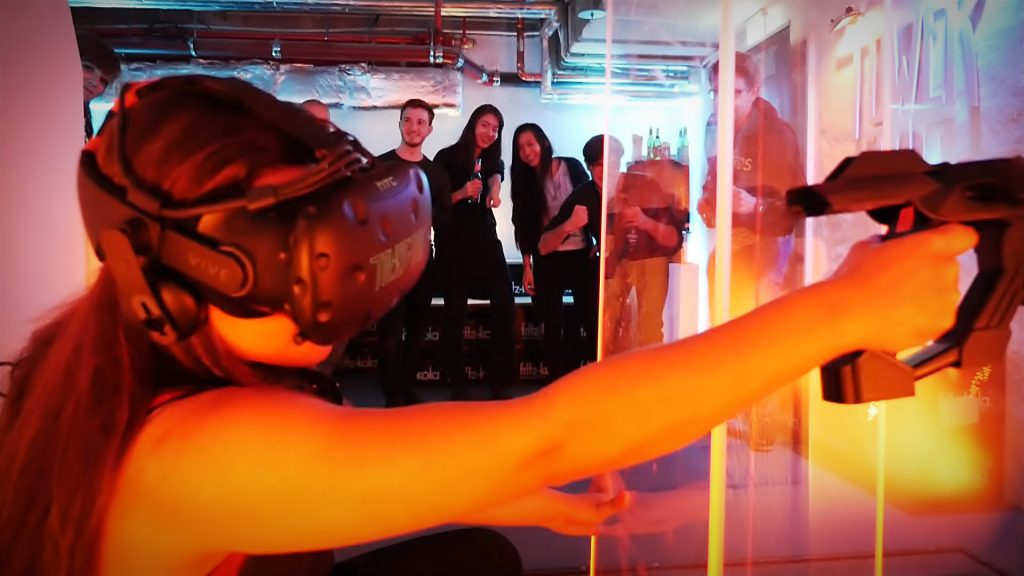
Another game that is going to crush it is called Tower Tag. It’s not yet available as a turnkey solution, but it might be the best VR game I have played yet. Up to six players can compete in teams of three in a laser tag-like competition, with a full, online tournament system built in. The game was invented by a former professional paintball player and laser tag enthusiast, and I could tell within the first minute of playing.
In Tower Tag, players have to move from tower to tower by shooting a rope-like beam and “pulling” themselves across the gaps. This unique mode of locomotion feels really intuitive, and never breaks immersion while eliminating motion discomfort. The game also has a great spectator mode, which is something else that is lacking in current VR games, but is about to get much better, and just in time, because one of the biggest challenges of operating a VR attraction is explaining the context of what it is.
Context is King
When I first started Laser Storm, one of the first laser tag systems in the world, I had to literally explain to people what it was. “Imagine you enter a dark room, and there’s glowing black light and fog, and you crawl around hunting for the enemy. You wear a vest and a headset, carry a phaser, and shoot beams of light at each other trying to score points.” We built viewing areas so people could come in and watch and get a taste of what it was like.
One of the biggest challenges facing location-based VR is creating a better spectator experience. Most locations tap into the video feed and show on a TV or projector what the player is seeing, but that first-person view doesn’t really give much context of what’s happening.
Some locations have installed green screens in the VR booths, and using cameras and old-school chromakey effects, can pull the player’s full body image out of the booth and project them into the virtual environment. This allows viewers to see the player in the game, and it creates a really wonderful spectator experience. But greenscreens are garishly ugly, and most FEC operators aren’t going to want them in their beautiful facilities.
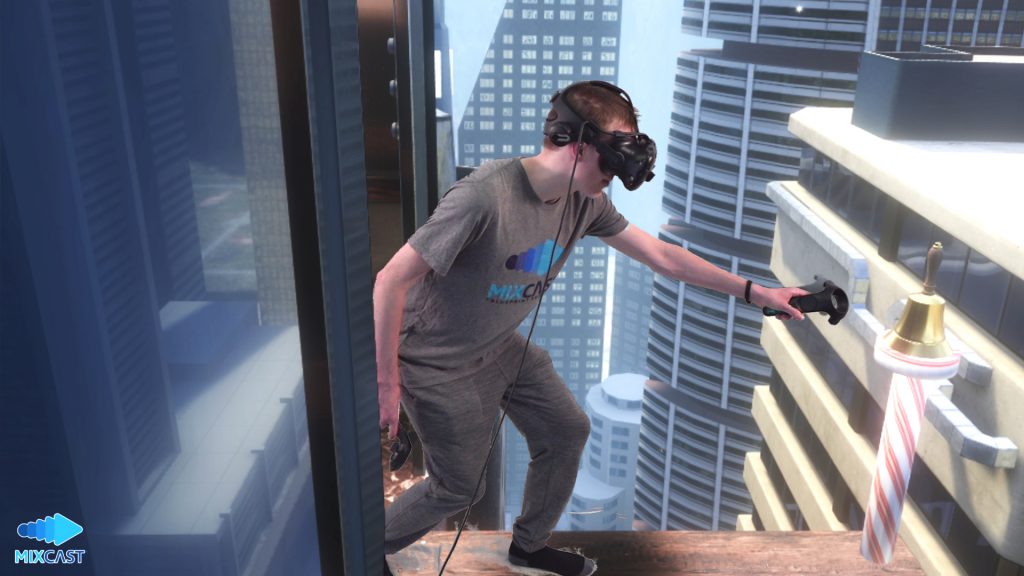
A company out of Vancouver called Blueprint Reality has solved that problem by taking that tech to the next level. Their latest Mixcast VR system uses an Intel Real Sense depth-sensing camera, and without a green screen they can not only “insert” the player’s body into the virtual game environment, but they record it and then let the player stream it to Twitch or YouTube, and share it to their social networks.
This technology holds the promise of not only creating a great spectating experience, attracting viewers to become participants, but it also becomes a great marketing platform for the location operator. Over two-thirds of surveyed VR arcade players said they found out about the arcade from a friend, with many of these recommendations coming from social media.
Another challenge for VR operators is creating the right positioning for their experience. Positioning is how you get people to understand what you are offering in relation to other entertainment options. The magic of VR is in its total immersion; that’s why people will pay top dollar and still rave about it to their friends.
But people aren’t walking around saying, “I want to be more immersed.” We live in a pretty damned immersive world as it is. It’s 3D, hi-resolution, zero latency, and comes with a full range of haptics. Anyone who has ever had sex can attest to the power of real-life to deliver an amazing immersive experience.
But for some reason operators are enamored with the technology, and more times than not, that’s what they try to sell. In the early days of laser tag, operators didn’t talk about the technology…we sold the experience! We helped people tap into their fantasy of being Luke Skywalker or Indiana Jones. We sold an adventure. I can only imagine if Laser Storm went to market with a sales pitch of “come try shooting beams of light at your friends.” We’d have gone out of business immediately. Yet that’s what I see from the vast majority of people in the VR business.
One of the best examples of marketing VR has come from The VOID. Their marketing and advertising hardly even mentions VR. It talks about the experience you will have with your family and friends…about being inside the action. “One second you’re standing on solid ground, the next you’re stepping deep into darkness, looking at unimaginable beauty – or fending off danger from another realm. Did you see it? Did you feel it? What’s next? You’ll just have to experience it to understand.”
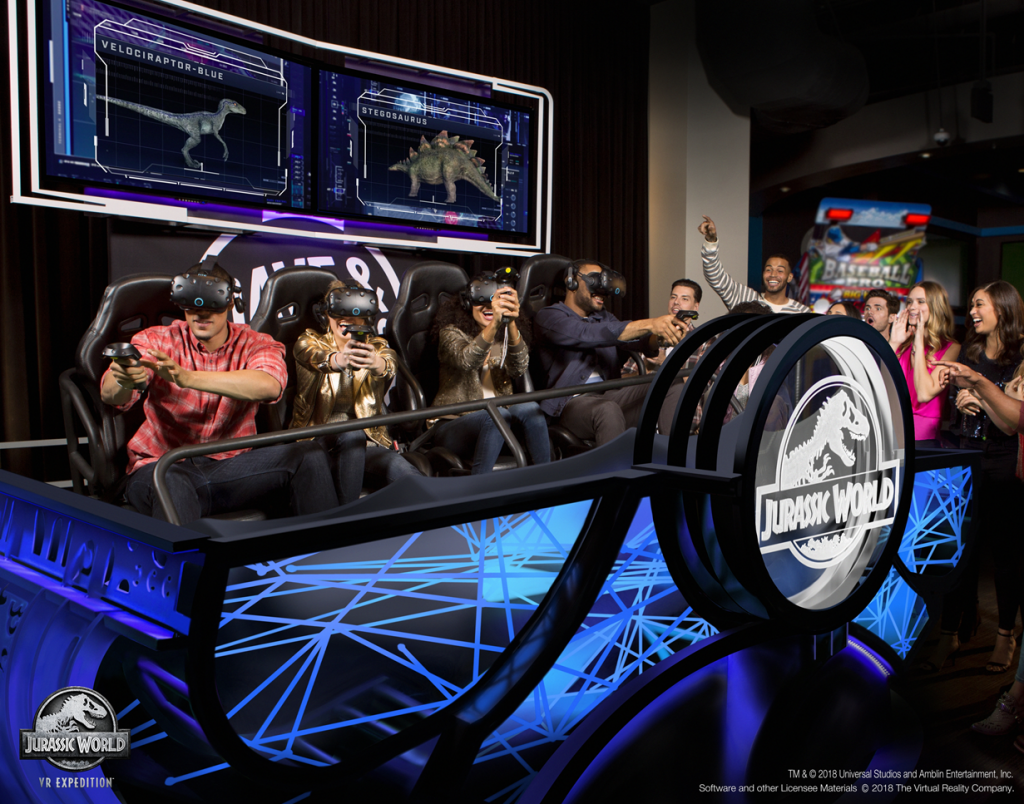
Kevin Bachus, SVP of Entertainment and Games Strategy at Dave & Buster’s, recently commented about how people market VR compared to arcade games. “When arcade games started incorporating large projection screens in them, we didn’t call them ‘Big Screen Arcade Games!’” We called them Alpine Racer, Prop Cycle, Time Crisis and House of the Dead. The technology just enabled a better experience. It seems this is a lesson VR operators need to learn if they want to attract the broad audience that’s actually clamoring for more immersive entertainment, but isn’t really enamored with the technology.
That audience is called Millennials, and it’s well documented they prefer experiences over things. They’re not really all about new tech. In fact, they seem to prefer pinball over VR, and while they’re all about electronic dance music (EDM) they also love vinyl records. To attract this elusive audience you need to really emphasize the experience over the technology.
I’ll continue to update RePlay readers on what’s happening in VR. In the meantime, if you’re interested in learning more about any of these attractions, just shoot me an email at [email protected]. Do likewise if you’re interested in joining my private VR Mentoring Group.
Electronic gaming and location-based entertainment veteran (and avid surfer) Bob Cooney helps companies with virtual and augmented reality solutions develop strategies to bring their products to the location-based entertainment market. He also helps operators navigate the stormy seas of disruption to select the best virtual reality solutions and experience for their locations. Bob has over 25 years of experience designing, manufacturing and marketing immersive out-of-home entertainment to consumers, operators and venues –– first as founder and chief executive of NASDAQ- and Inc. 500-listed Laser Storm, and later as an initial member of the Global VR executive team which introduced the first commercially viable virtual reality arcade game. Cooney went on to become VP of marketing and business development of Ecast, the digital content provider for jukeboxes, and COO of NTN Buzztime, the networked trivia game company. Cooney has been a driving force behind the development of numerous top-earning licensed games, including products based on EA Sports PGA Tour, X-MEN and Stargate, and has been a long-time vocal proponent of leveraging new technology to keep the out-of-home amusement industry relevant. To get in touch with Bob, visit www.bobcooney.com or email [email protected].
